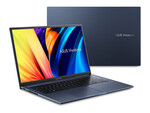Asus Vivobook 17 X1702, i5-1235U
Especificaciones de Portátil(es)

Price comparison
Análisis para el Asus Vivobook 17 X1702, i5-1235U
Origen: Laptop Media

Support, disponible online, Muy corto, Fecha: 01/24/2023
Origen: Laptop Media
 EN→ES
EN→ESAs usual, the low-to-medium budget section of the market is saturated with tons of good devices. Those of 17-inch size are not that popular but still get into the mix. In particular, Vivobook 17 (X1702) shows a decent performance, which doesn’t drop too much after long periods of time. More so, it provides some upgradeability, like a single RAM SODIMM slot (paired with some soldered memory), and an M.2 PCIe x4 slot for Gen 3 or Gen 4 storage. ASUS Vivobook 17 (X1702)’s 17-inch IPS panel has a Full HD resolution, good contrast ratio, and comfortable viewing angles. It doesn’t use PWM for brightness adjustment, which is great. However, its 52% sRGB color coverage is a limiting factor in visual perception. The disappointing color coverage is not too bad for a laptop in this price range. However, its battery life is drastically lower than that of one of its main competitors – the IdeaPad 3 (17″, 2022). It lasts nearly 3 hours less in Web browsing but closes that gap to a two-hour deficit in video playback. Unfortunately, this means that you won’t be able to use your device for an entire workday only on battery power. Thankfully, the comfort is not hindered, as its keyboard is great, while the touchpad is simply fantastic – Probably the best in its class. Again, you have to be wary of its port selection. Since there is no SD card reader of any sort, and the USB Type-C port is limited to data transfer only, we consider it to be unsatisfactory. At the end of the day, we think that Vivobook 17 (X1702) is worth considering. Especially if you find a good deal on it. What is a good deal on this device? Well, that’s if it’s cheaper than the IdeaPad 3 (17″, 2022).
Único Análisis, disponible online, Muy largo, Fecha: 01/24/2023
Comentario
Intel Iris Xe G7 80EUs:
Tarjeta gráfica integrada en los SoCs Intel Tiger Lake G7 basados en la nueva arquitectura Gen. 12 con 80 EUs (Execution Units / Shader Cluster). La velocidad de reloj depende del modelo de procesador. Los chips Tiger Lake se fabrican en el moderno proceso de 10nm+ de Intel.
Estas tarjetas también deben ser capaces de aguantar todos los juegos actuales, pero la mayoría de ellos en configuraciones de detalles medios y bajos y con bajas resoluciones. Juegos más antiguos, o menos exigentes todavía pueden ser jugados con buena calidad de gráficos.
>> Más información puede ser encontrada en nuestra comparación de tarjetas gráficas moviles y la lista de benchmarks.
i5-1235U:
Un procesador móvil basado en Alder-Lake con 2 núcleos de rendimiento y 8 núcleos eficientes. Los núcleos de rendimiento ofrecen hyper-threading, que permite procesar 12 hilos. La CPU funciona a frecuencias que oscilan entre 0,9 y 4,4 GHz. El TDP está especificado en 15 vatios.
>> Más información puede ser encontrada en nuestra comparación de procesadores móviles.



